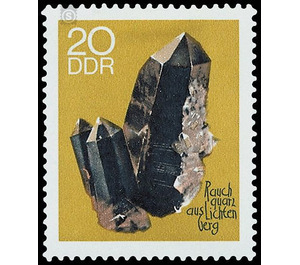Minerals from the collections of the Freiberg Mining Academy - Germany / German Democratic Republic 1969 - 20 Pfennig
Theme: Geology & Geography
| Country | Germany / German Democratic Republic |
| Issue Date | 1969 |
| Face Value | 20.00 |
| Color | green |
| Perforation | K 14 |
| Printing Type | Photogravure |
| Stamp Type | Postage stamp |
| Item Type | Stamp |
| Chronological Issue Number | 1213 |
| Chronological Chapter | GER-DDR |
| SID | 668581 |
| In 23 Wishlists | |
Beautiful minerals of the GDR The Ministry of Posts and Telecommunications of the GDR publishes a series with six multicolored special postage stamps on which beautiful minerals from the German Democratic Republic are depicted. Minerals of the GDR Many types and varieties of minerals have been described in the scientific literature for the first time in the Ore Mountains, the Thuringian Forest and the Harz. A large number of minerals occur in the territory of the German Democratic Republic in excellent quality and special beauty. For these reasons, minerals of our homeland can be found in all the major collections in the world. As in recent years again and again interesting findings of minerals were discovered in the GDR, the issue of a stamp series with mineral motifs is of particular relevance. The minerals displayed on the stamps were all found on the territory of the GDR today. The steps are stored in the mineralogical collection of the Geosciences section of the Bergakademie Freiberg. 20 Pfennig Value: Smoky Quartz SiO2, Lichtenberg near Ronneburg, Thuringia (No. 56417) Quartz is one of the most abundant minerals in the world, which is an essential constituent of most rocks in the Earth's crust. After the shape, structure, color and the emergence many different strongly divergent varieties are distinguished. The smoky quartz is characterized by smoky-brown to brown-black colorations and usually occurs in well-formed crystals in clefts and drusen cavities. The crystal group on the stamp is about 70 x 50 mm in size. The illustrated minerals give a little insight into the richness and beauty of the mineral deposits of the GDR. The exhibitions of the mineralogical collections at the Bergakademie in Freiberg (Saxony) and the Humboldt University in Berlin provide a much broader overview of this area of nature.


